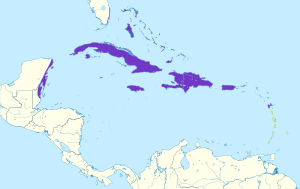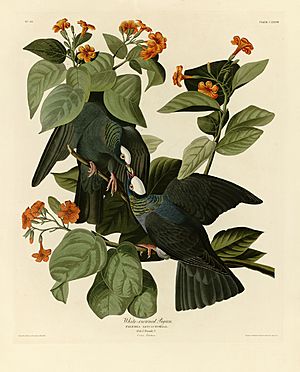White-crowned pigeon facts for kids
Quick facts for kids White-crowned pigeon |
|
|---|---|
 |
|
| In Florida, USA | |
| Conservation status | |
| Scientific classification | |
| Genus: |
Patagioenas
|
| Species: |
leucocephala
|
 |
|
| Synonyms | |
|
Columba leucocephala Linnaeus, 1758 |
|
The white-crowned pigeon (Patagioenas leucocephala) is a bird that eats fruits and seeds. It belongs to the dove and pigeon family, Columbidae. You can find these birds mostly in the Caribbean region.
A famous artist named John James Audubon painted these pigeons. His beautiful watercolor painting was part of his well-known book, Birds of America, which came out in the early 1800s.
Contents
What's in a Name? The White-Crowned Pigeon's Classification
Many naturalists studied and drew the white-crowned pigeon long ago. In 1758, a Swedish scientist named Carl Linnaeus gave this bird its scientific name. He called it Columba leucocephala.
The name leucocephala comes from Ancient Greek words. Leukos means "white," and -kephalos means "-headed." So, the name perfectly describes this "white-headed" pigeon! Today, scientists place this pigeon in a different group called Patagioenas. It is the main example for this group. There are no different types or subspecies of this pigeon.
What Does the White-Crowned Pigeon Look Like?
The white-crowned pigeon is about 29–35 cm (11–14 in) long. Its wings can spread 48–59 cm (19–23 in) wide. It weighs between 150–301 g (5.3–10.6 oz). This pigeon is similar in size to the common rock pigeon. However, it is a bit lighter and has a longer, more square-shaped tail.
Adult birds are usually a dark gray color, sometimes almost black. They have a special patch on their neck that shines with green and white patterns. You can only see this shimmer in good light. The white patch on their head, called the crown, can be bright white in males. In most females, it is a more grayish-white. Young pigeons are a lighter gray-brown. They do not have the neck pattern or the white eyes of the adults. They only show a few light feathers on their crown.
These pigeons have white eyes and a red beak with a pale tip. Their call is a loud, deep sound that sounds like coo-cura-coo or coo-croo.
Where Do White-Crowned Pigeons Live?
White-crowned pigeons live and breed mainly in the the Bahamas, Cuba, Jamaica, and Antigua. You can also find smaller numbers of them breeding in Hispaniola (which includes the Dominican Republic and Haiti), Puerto Rico, the Virgin Islands, the Cayman Islands, Anguilla, and other Caribbean islands. They also breed along the Caribbean coast of Central America.
In the United States, these birds are only found in the Florida Keys, the Everglades, and the very southern part of mainland Florida. They often spend the winter months in the Caribbean islands.
These pigeons usually live and nest in large groups. They prefer low-lying coastal areas with mangrove forests. From these nesting spots, they travel inland to find food. They eat fruits and seeds from many different plants. In Florida, they have historically nested on remote islands covered in mangroves. These islands are often flooded by tides. Recently, they have also been seen nesting on the southern tip of mainland Florida.
White-crowned pigeons generally need isolated mangrove islands to breed safely. These islands, flooded by tides, help protect them from predators like raccoons. However, some pigeons have recently started nesting in busy city areas, like downtown Key West and Miami, Florida. This might be happening because hurricanes have destroyed their natural homes. Also, there might be more predators in their usual nesting areas.
What Threats Do White-Crowned Pigeons Face?
One of the biggest dangers to white-crowned pigeons is the loss of their habitat. This happens when forests are cut down or their natural homes are damaged. These pigeons need two different types of habitats: one for nesting and one for feeding.
They usually nest in coastal red mangroves (Rhizophora mangle). These mangroves are often cut down to make room for crops like sugarcane. Farming and cutting down trees are also problems for their feeding grounds. These are usually inland hardwood forests. The white-crowned pigeon is a very shy bird. It is known to leave its nest if people or disturbances come too close. In Florida, they often eat the fruit of a plant called poisonwood. This plant can cause skin problems for humans, so it is often removed.
White-crowned pigeons are also hunted in many parts of their range. Even though hunting rules have changed in the Bahamas, illegal hunting is still a problem for these birds.
Other dangers to these pigeons include:
- In Florida, many pigeons die from hitting man-made objects like buildings or power lines.
- The use of pesticides can also harm them.
Like the extinct passenger pigeon, the white-crowned pigeon shows an important lesson about protecting animals. We do not always have to kill every last pair of a species for it to disappear. These birds are "threatened by the killing of nesting birds in their Caribbean breeding grounds."
See also
In Spanish: Paloma coronita para niños



